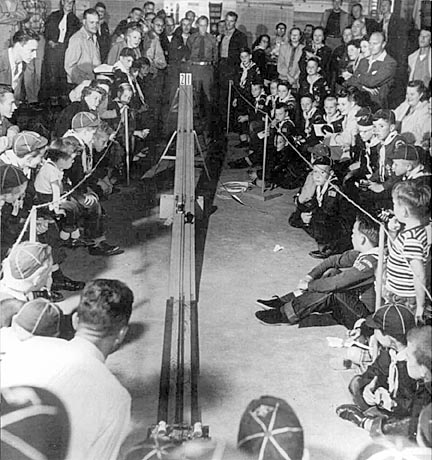

PINEWOOD DERBY!
Introduction:
Because the Pinewood Derby grew primarily through a grass roots movement, much of it's early history and development has been lost. This page is an attempt to bring together as much information as possible not only of the Boys Scouts Pinewood Derby program, but also the many spin-offs that have occurred over the last sixty years.
The very first pinewood derby race was held on May 15, 1953 in the scout house in Manhattan Beach, California and was hosted by Cub Scout Pack 280C, the present Pack 713.

An image of the first Pinewood Derby race
The race was the idea of Cubmaster Don Murphy as a substitute for Cub Scouts too young for the then immensely popular soap box derby. Thanks to an aggressive advertising program by the Scouts and their sponsor, North American Aviation, the race was a huge success. The track was a two-laner, made of wood and 31 feet long, which is very short compared to today's standard 42 feet.
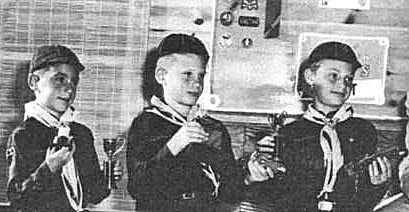
The very first Pinewood Derby Champions from left to right: Dennis Lowies age 8, Richard Hoffman age 10 and Mike Thorne age 9.
The extremely low cost of making the cars, the smaller venues required for staging races compared to soap box racing and America's passion for all things related to race cars fueled Pinewood Derby's rapid spread. The October, 1954 edition of Boys Life magazine featured an article about pinewood derby racing that introduced it to the entire Nation. On March 17, 1954, the Herald Express Newspaper and the Los Angeles Recreation and Parks department teamed to sponsor the first non-Boy Scout pinewood derby-type race in Griffith park. In 1955, The Boys Scouts of America recognized it as a official scout activity. Within a few years Pinewood derby racing had surpassed soap box racing in popularity, the activity to which it was originally considered subordinate.
Early pinewood derby kits consisted of a partially precut block of wood suggesting a profile similar to 1940s Indianapolis 500 race cars, plastic wheels, axles and two smaller pieces of wood for mounting the axles on the car body.
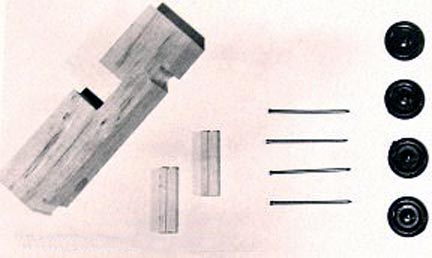
Early car kit.

One of the suggested designs from the 1954 Boys Life article.
In 1980 the kits went to using solid blocks and improved wheels. In 2009 the wheels were improved a second time, making them the most sophisticated stock wheel sold by any pinewood derby car kit company.
The most recent change to Boy Scout Pinewood Derby racing is the introduction of the new 18-wheeler class, where scouts build larger truck-styled vehicles.
Organizationally, then as now, each Scout den and district is free to decide what rules will be used for their particular race. This results in considerable variation on what constitutes an acceptable car. While they all agree that the cars should be seven inches long and weigh no more than five ounce, issues of wheel base length, number of wheels and how much work can be performed on the wheels change significantly from pack to pack.
As of 2014, over 2,000,000 youths race some type of pinewood derby car every year in the United States. Millions more are raced across the world.
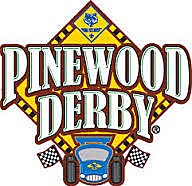
Originally intended as a pack event, Pinewood Derby quickly grew to the point where there were district, area and even national championships were held.
The following video provides and idea of what a pinewood derby race is like:
The Girl Scouts were the first organization outside of the Boy Scouts to officially embrace pinewood derby racing in the late 1950s. Originally called the Powder Puff Derby, in recent times the more politically correct title Grand Prix is used more often. They use that same car kits made for boy scouts and the rules are the same. The following video shows one of their races:
The
AWANA pinewood
racing program was the
next significant event in the evolution of pinewood derby racing.
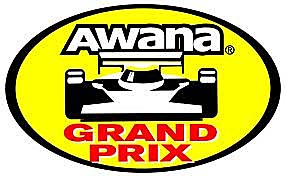
In 1964. Mr. Ken Starett had a very successful AWANA youth program at the First Baptist Church in Elyria, Ohio. The only problem was he needed a way to attract more fathers into the program. One day he noticed a large group of people in the town's park attending a Boy Scout pinewood derby race. Instantly, he realized that this was the sort of event the would tempt fathers to become more involved. It worked, and its success spread through the national AWANA community like wildfire. It is now the second most attended pinewood derby-type race in the US.
In 1985, the Woodland Scenics company, that makes landscaping miniatures for railroad modelers, began marketing their Pinecar Kits to hobby and craft stores across the United States. These kits are similar to Boy Scout kits and are designed for non-scout related organizations to host pinewood derby-type races. The venture was a success and Pinecar is now the most widely sold pinewood derby kit available.
The third most popular pinewood derby-type race is the Royal Racers, sponsored by the Southern Baptist Royal Ambassadors youth program, which is intended to guide youths toward Christian missionary service. Their car kits are different in that they offer a optional rounded or retro-style wheel in addition to the flat treaded wheels everyone else uses.
There are many other organizations that use pinewood derby racing as character building and entertainment activities. Regrettably, there are no readily available records on where, when and how they began. But all of them can trace their roots to the first race in 1953. Here are a few of them:
Calvinist Cadet Corps Model Car Derby
Christian Service Brigade Shape N Race Derby
Royal Rangers Pinewood Derby uses the original narrow wheel, adjustable screw axles and axle mounting dowels.
Scouts Canada hosts the Kub Kar Rally, Beaver Buddies and Express Truck Derbies.
Trail Life USA has the Trail Life Grand Prix
The YMCA holds Chule Car Races, which are similar to Royal Rangers cars.
The Woodcar Independent Racing League (www.wirlracing.com) began in 2004 and is open to anyone of any age. It's a racing venue in which racers mail their cars to a central location to compete against racers from all over the world. The problem is that the latest race results only go up to 2011, suggesting it may no longer be active.
Similar to it is the Pro Derby Drag Racing organization. (www.p-d-d-r.com) Started in 2006, this organization enables racers to mail their cars to a race center, compete in one of several different classifications and then have them mailed back. The following video shows one of their races:
Although it seems to have suffered through a recent hiatus, it has race results from 2014 so I assume it's still active.
Conclusion:
Over the last 60 years Pinewood Derby racing has been embraced by almost every nation on the Earth and is one of the most participated-in youth activities anywhere. I hope this page helped provide a sense of its history. For more information about pinewood derby racing, how to build cars, build tracks and run a race, please visit the Pinewood Derby Section of the website THIS AND THAT. Thank you for visiting.
Return to my main page to browse 60 other subjects